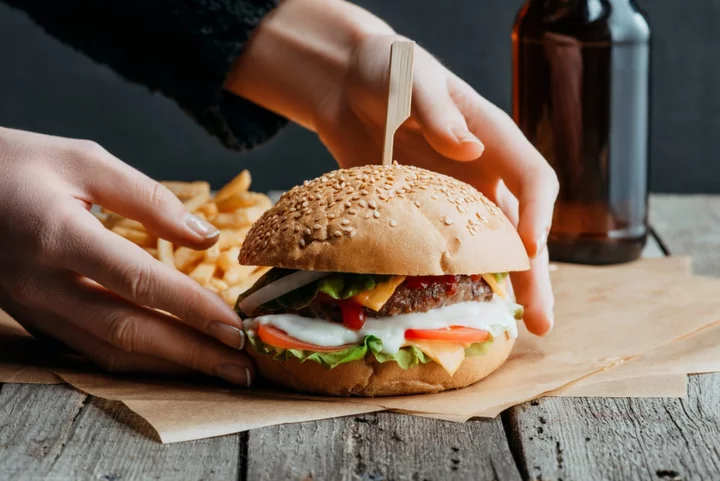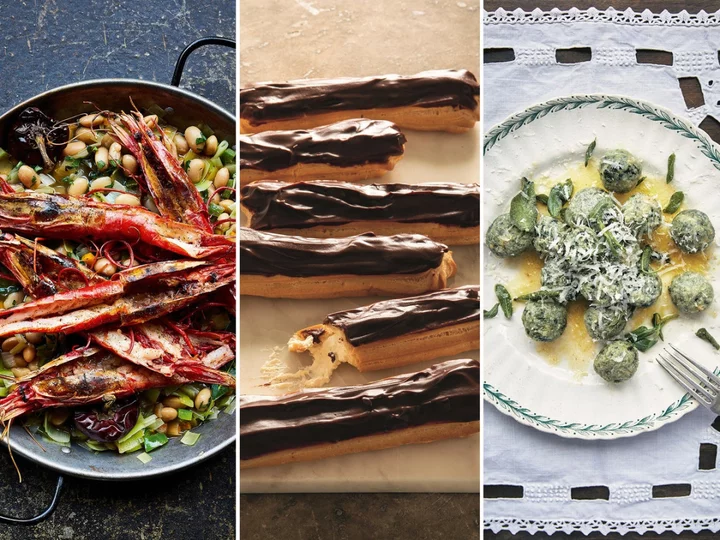
Red Flags: 5 college football teams on upset alert in Week 13
Check out which college football upset picks for Week 13 have these Top 25 ranked teams on upset alert in rivalry week.
2023-11-22 20:17

A Biotech Slump Is Emptying Labs and Threatening Research on New Drugs
Sangamo Therapeutics Inc.’s cost cuts didn’t hurt just the roughly 162 US workers who lost their jobs this
2023-11-22 19:45

Corporate America Is Rethinking Diversity Hiring
The same conservative activists who helped gut race-related college admissions at the US Supreme Court have now set
2023-11-22 18:56

Barcelona legend insists Jude Bellingham didn't deserve Golden Boy award
Barcelona legend and 1994 Ballon d'Or winner Hristo Stoichkov claims that Jamal Musiala or Alejandro Balde should have won the 2023 Golden Boy award instead of Jude Bellingham.
2023-11-22 18:49

Florentino Perez sends letter to Gavi following ACL injury
Real Madrid club president Florentino Perez sent a letter to Barcelona midfielder Gavi wishing him the best after he suffered an ACL tear and meniscus damage in Spain's 3-1 win against Georgia on Sunday.
2023-11-22 18:24

Mayo slander doesn’t make you a foodie – it makes you boring
As if to prove a point, I am sitting in front of my computer, typing with one hand and dipping chicken nuggets into mayonnaise with the other. Admittedly, it’s not even the good stuff – it’s M&S-branded mayonnaise, which is fine but certainly no substitute for a delicious Hellman’s. But to me, all mayonnaise, even not-very-good-mayonnaise, is the good stuff. This might come as a surprise. As a food writer, I’m often expected to rise above the simple condiments. The circles I run in, usually full of food lovers and taste-makers, tend to decry mayonnaise, which pains me. “God, I hate mayo,” some of them proclaim. This happened to me not long ago while getting chips at Wetherspoons, as if we were even eating at some sort of paragon of British cuisine. “Mayonnaise is boring!” they shout. “It’s got no flavour! It looks gross!” I cringe because I was about to help myself to the squeezy bottle. I’ve often felt embarrassed by my love for this apparently bland condiment. When the people around me make announcements about the awfulness of mayonnaise, I wonder if my reputation as a gastronome will be tarnished by the sizeable dollop I like to add to the side of my plate. But I’ve noticed a pattern of late, and it’s time to address it: the people who shout obnoxiously about hating mayonnaise are usually white people who are self-described “foodies”, which is perhaps one of the cringiest words of the 21st century. And I’ve had it. I think it’s self-loathing, really. The same white people who decry mayonnaise see themselves in its milky complexion and feel the need to prove that they are different – exotic, even. Maybe it’s even a way of distancing themselves from the proverbial sins of their fathers. But mayo slander won’t give you a blank slate to reinvent yourself. In fact, it’s been unfairly vilified as plain and dull for too long. It’s one of the UK’s favourite condiments – second only to ketchup – for good reason, and has far more potential than we give it credit for. How do I love thee, mayonnaise? Let me count the ways. Firstly, the way it’s made is pure magic. Eggs? Oil? White vinegar? Lemon? As they are, they don’t really make any sense. But blending them somehow creates a smooth, thick, creamy emulsion. Who on earth discovered this? There are numerous legends about how mayonnaise was first invented; some food historians say it was the French, others point to the Spanish. The sauce can be traced back to 1756, and has gone through many iterations before arriving as the eggy, almost jelly-like substance we know today. The other thing I love about mayonnaise is how versatile it is. You can mix it with just about anything – this is something Heinz does with abandon, selling varieties like Mayomust (mayo and mustard) and Mayocue (mayo and barbecue sauce). I draw the line at some of the brand’s more Frankenstein-esque creations – monstrosities such as Creme Egg mayo and hot cross bun mayo. Some things are better left alone. But mayonnaise mixed with other savoury condiments is revelatory, one of my favourites being sriracha mayo. I would highly recommend making your own mixes, as this lets you decide on a ratio that works for you and means you won’t have to stoop so low as to buy anything labelled “Mayoracha”. Mayonnaise also has far more uses than just dipping. You could mix it with ketchup to make a thousand island dressing for salad (although maybe don’t check any calorie counts if you do this… I certainly don’t). One of the best tips I’ve ever been given is to spread a thin layer of mayonnaise instead of butter over the outside of your cheese toasties before grilling them – the fat in the mayonnaise and its uber-spreadable texture will help you achieve an even browning all over the bread. It has non-food uses, too. You can use mayonnaise, for example, to marinade chicken, which yields tender, juicy meat with loads of flavour. Finally, trying different types of mayonnaise from other countries has been quite an adventure for me. Japanese mayonnaise – my utmost favourite – is tangier due to the use of rice vinegar, as well as more unctuous in texture than regular mayonnaise. I squeeze squiggles of it over scrambled eggs, freshly steamed rice, fried chicken, anything. Dutch mayonnaise is richer and more flavourful, which makes dipping chips into it feel quite luxurious. While I have yet to try Russian mayonnaise, I imagine it is just wonderful, considering Russia is the only market in Europe that sells more mayonnaise than ketchup. My love for mayonnaise knows no bounds. Well, there are some bounds; I wouldn’t choose to emulate Kingsman star Taron Egerton, who once told the Off Menu podcast he spreads mayonnaise on his pizza like butter on a slice of bread. That’s taking things a bit too far. And I won’t touch any sweet mayonnaise atrocities. But I urge anyone who’s ever uttered the words “I hate mayonnaise” to give it another chance. Especially if you’re white. Reclaim your condiment! As for me, I’m done with being embarrassed about loving mayo. In fact, I’m off to buy more. Read More Best wines to pair with Thanksgiving dinner Three easy cranberry sauce recipes to try this Thanksgiving Vegetarian and vegan alternatives to classic Thanksgiving recipes
2023-11-22 14:48

David Alaba responds to speculation about Real Madrid future
David Alaba has responded to reports that he could leave Real Madrid and commented on former club Bayern Munich's start to the season.
2023-11-22 01:18

NFL fantasy football waiver wire pickups for Week 12
With the fantasy football playoffs quickly approaching, now is the time to be proactive on the waivers ahead of Week 12.
2023-11-21 22:20

New ETF Tracks Developers of Obesity Drugs Amid Ozempic Hype
A niche issuer is launching a biotechnology exchange-traded fund whose key holdings include firms benefiting from the hype
2023-11-21 20:50

Kylian Mbappe discusses PSG future amid Real Madrid links
Kylian Mbappe has insisted that his future at Paris Saint-Germain "will be resolved one day" amid speculation that he's set to join Real Madrid in the summer.
2023-11-21 19:26

Three new cookbooks worth buying, from James Martin to the Hairy Bikers
This is the best time of year to discover new recipes. As the days get shorter and colder, a glossy new cookbook – and all the food-related inspiration that comes with it – can be just the thing you need. And there are plenty of new releases to sink your teeth into – whether you want to transport yourself to a sunnier country, settle down with some comfort food – or even get a head start on Christmas shopping. Some of the biggest names in food – including chef and former Saturday Kitchen presenter James Martin, BBC stalwarts the Hairy Bikers, and cult restaurateur Russell Norman – have new cookbooks out – and this is what you can expect from each of them. 1. ‘James Martin’s Spanish Adventure’ by James Martin If you were captivated by James Martin’s 20-part ITV series taking a culinary tour around Spain – from the Michelin-starred restaurants of San Sebastian to the local markets of Santiago de Compostela – you’ll want to pick up the accompanying cookbook. One of Martin’s favourite areas in the country is Toledo, “a special ancient city right in the middle of Spain”, he notes. “It’s famous for great produce including game, saffron, honey, olive oil, garlic and the list goes on.” Yorkshire-born Martin says he first fell in love with Spanish food when he came to London as a young chef, and wanted to dedicate this book to the cuisine because he “wanted people to know about the people, the fantastic variety of landscapes, and the spectacular produce available”, he says. “They have the best markets in Europe and the range of ingredients is fabulous – the seafood, the meat, the vegetables and the fruit.” In the cookbook, Martin highlights that Spanish cuisine is far more than just paella and sangria. There are plenty of recipes for traditional dishes – including tapas bites, croquetas, empanadas, Seville pork with patatas bravas and burnt Basque cheesecake – as well as classic Spanish ingredients (such as chorizo, olives and plenty of seafood). While Spain is predominantly known for meat and fish, Martin also shows some of the beautiful ways the country uses vegetables too – such as a dish for deep-fried aubergines drizzled with honey and served with a tomato sauce, and salt-baked celeriac with new potatoes and salsa. Valencia beans and red prawns “Located on the east coast, the 2,000-year-old city of Valencia boasts wide sandy beaches, striking architecture, a buzzing food scene and culture,” says Martin. “It has its own language (a dialect of Catalan) and unique cuisine, with a focus on rice, seafood and meat. This dish showcases red prawns on a bed of white beans and vegetables.” Serves: 2 Ingredients: 75ml olive oil, plus extra for drizzling 2 garlic cloves, chopped 1 onion, diced ¼ leek, diced ½ carrot, peeled and diced ¼ green pepper, cored, deseeded and diced 3 bay leaves 2 whole smoked chilli peppers (or a pinch of chilli flakes) 300g cooked butter beans Splash of white wine Small bunch of flat-leaf parsley, chopped 8 red prawns, split lengthways Sea salt Method: 1. If you want to use a BBQ, heat a BBQ until hot and the coals are white. 2. Heat a medium paella pan and, when hot, add the oil, then add the garlic, all the vegetables, the bay leaves and the smoked peppers. Cook for two to three minutes, then stir in the beans, 50 millilitres of water and the wine and cook for three to four minutes. Season with salt and finish with the parsley. 3. Meanwhile, pop the prawns onto the BBQ, drizzle with oil and season with salt, then cook for two to three minutes until charred, turning once or twice. Alternatively, grill on high for three to four minutes. 4. To serve, remove the smoked peppers (if using) from the beans and then pile the prawns on top of the beans and drizzle with extra olive oil if desired. ‘James Martin’s Spanish Adventure’ by James Martin (Quadrille, £27) 2. ‘The Hairy Bikers’ Ultimate Comfort Food’ by Si King and Dave Myers It’s hard to believe Dave Myers and Si King – otherwise known as the Hairy Bikers – have been on our screens for nearly two decades, with their first BBC show airing in 2004. They’ve written plenty of cookbooks over the years – dedicated to everything from Mediterranean food to curries – and their latest is all about comfort food. In the introduction, the duo think back to what comfort food meant to them growing up – for Myers, it’s a classic chip butty, and King picks out his mother’s curries and casseroles. British classics like these permeate the book – including beef and barley stew, sausage rolls and lemon drizzle cake – but there’s a definite international flavour, with dishes inspired by Myers and King’s travels all over the world. Think soba noodles with miso mushrooms, Szechuan lamb bao buns, chipotle prawn tacos and more. While comfort food might make you think of heavy, rich dishes you want to curl up in the winter with – and those recipes are represented – there’s also a wider picture of ‘comfort’ and what it means throughout the year. Lighter recipes such as the teriyaki chicken salad and Spanish-style roasted vegetables with halloumi will bring just as much joy in the summertime. Chocolate eclairs “Possibly everyone’s top teatime pleasure, eclairs are a bit of work, but are so worth it,” say Myers and King. “Just picture yourself biting into that beautiful choux pastry filled with cream and spread with chocolate.” Makes: about 8-12 Ingredients: For the choux pastry: 115g plain flour 100g butter 2 tsp caster sugar 1 tsp vanilla extract Pinch of salt 3 eggs, well beaten 1 tbsp icing sugar For the filling: 300ml double cream 1 tbsp icing sugar ½ tsp vanilla extract For the chocolate glaze: 100g dark chocolate (or 50g dark chocolate and 50g milk chocolate) 50g whipping cream 50g butter 25g golden syrup Method: 1. Preheat the oven to 180C/fan 160C/gas 4 and line two baking trays with baking parchment. Sift the flour on to another piece of baking parchment. 2. Put the butter, sugar, and vanilla extract in a pan with 225 millilitres of water and a generous pinch of salt. Heat gently until the butter has melted and the sugar has dissolved, then turn up the heat until the mixture is boiling. Remove the pan from the heat. 3. Pull up the sides of the baking parchment and slide the flour into the butter and sugar mixture. Stir the flour into the wet ingredients to form a thick paste which should come away from the sides of the pan in one solid mass. Put the pan back over a gentle heat and continue stirring with a wooden spoon for two or three minutes, until the mixture is slightly steaming and leaves a floury residue on the base of the pan. 4. Leave to cool for a couple of minutes, then beat for a couple of minutes more. You can then transfer the dough to a stand mixer or use electric beaters if you prefer. You will see steam escape from the dough at this point. Keep beating until the steam has subsided. 5. Gradually work in the eggs, just a couple of tablespoons at a time, until you have a thick glossy dough – it needs to be quite stiff and firm enough for you to draw your finger through it without the sides falling back in. The dough initially breaks up a lot, but eventually it will come together again. 6. Fit a large star or plain round nozzle into a piping bag and scoop the dough into the bag. If you don’t have a nozzle, simply snip off the end of the bag off – the hole should be about 2.5cm wide. 7. Pipe tiny amounts of the dough under the corners of the baking parchment on the trays to keep the parchment in place. For large eclairs, pipe eight lines of dough, as evenly as possible, on to the baking trays, making each one about 15cm long. To make sure they don’t spread to an oval shape, pipe them slightly wider at each end. To make slightly smaller eclairs, pipe 12 lines of about 10cm long. Wet your fingers and smooth out the ends of the eclairs if peaks have formed. If you haven’t used a star nozzle, run a fork along the length of each one. 8. Dust the eclairs with the icing sugar – this will help them darken and crisp up in the oven. Bake for 25 minutes by which time they should have formed a crust. Use a skewer to poke holes in each end of the eclairs so steam can escape from their centres, then continue to bake for another eight to 10 minutes. Turn the oven off and leave the door ajar. Leave the eclairs in the oven for about half an hour – this will help make sure they are crisp all the way through. 9. To make the filling, whip the cream until it is stiff, then fold in the icing sugar and vanilla extract. Chill for half an hour. 10. For the glaze, put the chocolate, cream, butter and golden syrup into a bowl over a saucepan of simmering water. Melt together gently to make a fairly thin ganache. 11. To fill the eclairs, cut three holes in the base of each one. Fill a piping bag with the cream and pipe it into the holes. Squeeze the eclairs lightly – they should feel nicely full. Dip each filled eclair in the chocolate glaze – this gives a much better coverage than trying to spread it – then leave them in the fridge to set. These are best eaten on the same day they are made as the pastry will eventually soften, but they will keep for up to 48 hours. ‘The Hairy Bikers: Ultimate Comfort Food’ by Si King and Dave Myers (Seven Dials, £25) 3. ‘Brutto’ by Russell Norman Russell Norman’s debut cookbook, Polpo, won the Inaugural Waterstones Book of the Year back in 2012, and anything the London restaurateur has done since has always been hotly anticipated. For his latest cookbook, Norman has turned his sights on Florence. Named after one of his London restaurants, “brutto” is the Italian word for ugly, and references the Italian expression, “brutto ma buono” – ugly but good. Tuscan cuisine is known for meat, offal, game and beans, Norman explains in the introduction – and these are all represented in the cookbook, albeit with a few more veggie options than you might seen in a traditional Florentine kitchen. You’ll learn a lot about food in Florence from Brutto – such as the city’s passion for wine bars, where antipasti such as coccoli (fried dough balls served with prosciutto and soft cheese) and deep-fried courgette flowers are served. Some of the recipes are Italian classics you’ll know about – such as tagliatelle with ragu and asparagus risotto – and others are more unusual, deeper dives into Italian cuisine – think Florentine-style fried chicken or an oven-baked spinach dish cooked with eggs, cream, Parmesan and a dash of nutmeg. Tuscan food is largely known as peasant food – meaning it’s relatively cheap and easy to make, while still being packed full of flavour. Spinach and ricotta dumplings “Gnudi translates as ‘naked’, as these little dumplings are the most nude and simple form of homemade pasta you can make,” says Norman. “The combination of spinach and ricotta is a very traditional marriage and appears in much of the pasta of the region, in ravioli and crespelle for example. It’s a very satisfying process, and easy enough for children to help with in the kitchen if you want to encourage an early interest in Italian cooking for little chefs.” Serves: 4 Ingredients: 500g baby spinach leaves, washed 50g ‘00’ flour 250g ricotta 1 large free-range egg, beaten 150g grated parmesan Flaky sea salt Black pepper ½ tsp freshly grated nutmeg 250g semolina 100g butter A large handful of sage leaves Method: 1. Steam the spinach for three minutes over a large pan of boiling water. Thoroughly drain and squeeze to remove the excess water, then chop the leaves finely. Set aside. 2. Mix the flour with the ricotta in a large bowl until it resembles lumpy breadcrumbs. Stir in the egg and two-thirds of the Parmesan. Add a pinch of salt, a twist of black pepper, the nutmeg and then add the spinach. Combine thoroughly with a wooden spoon or with your hands. 3. Put half the semolina into a bowl and shake the rest on to a baking sheet or a tray. Take small lumps of the flour, egg and spinach mixture and form them into small balls by rolling them between your palms, to the size of large olives. Turn each ball through the bowl of semolina, then place on the tray you’ve prepared with the rest of the semolina. When finished, you should have 24–30 little balls. 4. Fill a very large pan with water and bring to a rolling boil. Place the gnudi in the boiling water as quickly as possible, bringing it back to the boil on the highest heat, and continue to simmer for about three minutes. 5. Meanwhile, in a small saucepan over a medium heat, melt the butter and add the sage leaves. When it bubbles, reduce to a very low heat. This should take no more than two minutes, while the gnudi are cooking. 6. The gnudi will float to the surface when they are ready. Turn off the heat, remove them with a slotted spoon and drain the excess water on kitchen paper. Place on four warmed plates, pour the butter and sage over the top, then evenly distribute the remaining Parmesan. Add a flourish of black pepper. ‘Brutto’ by Russell Norman (Ebury Press, £32) Read More From a £22 bag of pasta to £28 sandwich – why do they cost so much? How to host a dinner party for under £2 per portion Pearly Cow, Margate, restaurant review: Go for the steak, but stay for the potatoes Three authentic Thai recipes to try at home What does Saturday Kitchen’s Matt Tebbutt cook at home? Three recipes that prove traditional Irish food is better than you think
2023-11-21 14:55

Uttarakhand tunnel collapse: First video emerges of Indian workers stuck in tunnel
The 41 workers have been trapped in an under-construction tunnel in northern India since 12 November.
2023-11-21 13:26
